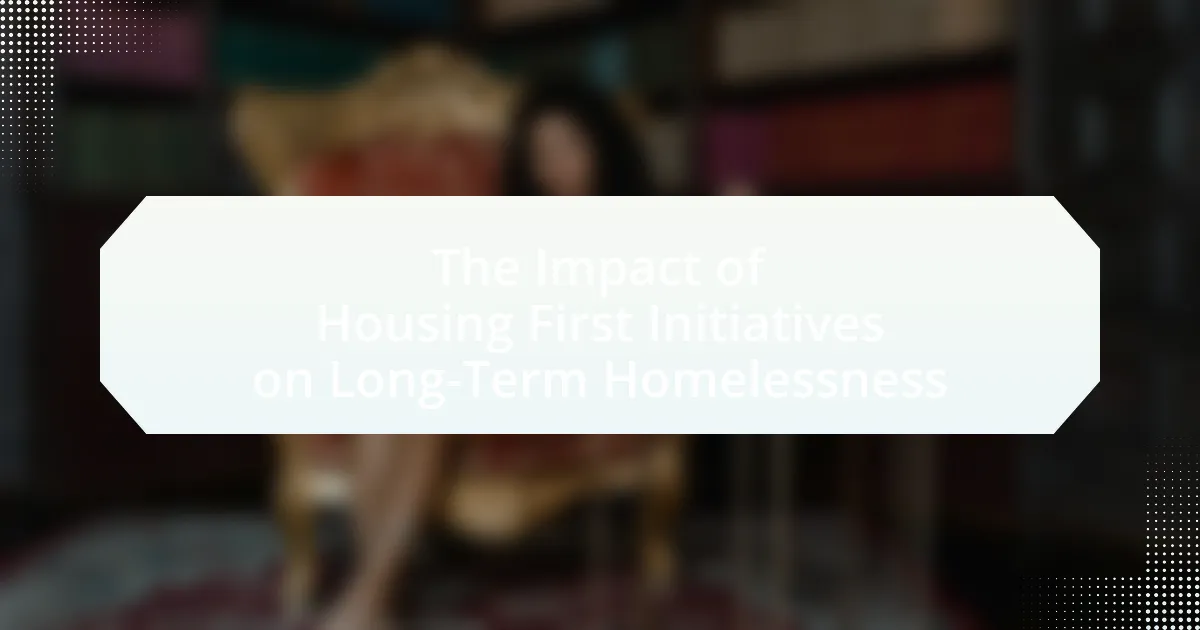Housing First Initiatives are programs aimed at providing permanent housing to individuals experiencing homelessness without preconditions such as sobriety or employment. This article examines the effectiveness of Housing First approaches in reducing long-term homelessness, highlighting their principles, implementation strategies, and the populations most affected. It discusses the significant improvements in housing stability and overall well-being for participants, supported by research indicating high retention rates and reduced reliance on emergency services. Additionally, the article addresses the challenges faced by these initiatives, including funding limitations and community perceptions, while emphasizing best practices for enhancing their effectiveness.

What are Housing First Initiatives?
Housing First Initiatives are programs designed to provide permanent housing to individuals experiencing homelessness without preconditions such as sobriety or employment. These initiatives prioritize stable housing as a fundamental step toward improving overall well-being and addressing other issues like mental health or substance use. Research has shown that Housing First approaches lead to significant reductions in homelessness, with studies indicating that participants are more likely to remain housed compared to those in traditional models that require treatment compliance before housing access. For example, a study published in the American Journal of Public Health found that 80% of participants in a Housing First program remained housed after two years, demonstrating the effectiveness of this model in combating long-term homelessness.
How do Housing First Initiatives differ from traditional approaches to homelessness?
Housing First Initiatives differ from traditional approaches to homelessness by prioritizing immediate access to permanent housing without preconditions, such as sobriety or employment. Traditional approaches often require individuals to meet certain criteria or engage in treatment programs before receiving housing assistance, which can delay or prevent access to stable living conditions. Research indicates that Housing First models lead to higher rates of housing retention, with studies showing that 80-90% of participants remain housed after one year, compared to lower retention rates in traditional models. This approach effectively addresses the root causes of homelessness by providing stability first, allowing individuals to focus on other aspects of their lives, such as health and employment.
What principles underpin Housing First Initiatives?
Housing First Initiatives are underpinned by several key principles, including immediate access to permanent housing, the provision of supportive services, and the belief that housing is a basic human right. These initiatives prioritize placing individuals experiencing homelessness into stable housing without preconditions, such as sobriety or employment. Research indicates that this approach significantly reduces homelessness and improves overall well-being, as evidenced by studies showing that 80% of participants in Housing First programs maintain their housing after two years. Additionally, the model emphasizes client choice and self-determination, allowing individuals to make decisions about their own lives and support services.
How are Housing First programs implemented in various communities?
Housing First programs are implemented in various communities through a model that prioritizes providing permanent housing to individuals experiencing homelessness without preconditions. Communities typically establish partnerships among local governments, non-profit organizations, and service providers to create a supportive infrastructure that includes housing assistance, case management, and access to social services. For example, the National Alliance to End Homelessness reports that cities like Salt Lake City and Houston have successfully reduced homelessness by adopting Housing First strategies, demonstrating a significant decrease in the number of individuals living on the streets. These implementations often involve tailored approaches that consider local needs, available resources, and the specific demographics of the homeless population, ensuring that the programs are effective and sustainable.
What populations are most affected by long-term homelessness?
Individuals with mental health disorders, substance use issues, veterans, and families with children are the populations most affected by long-term homelessness. Research indicates that approximately 30% of homeless individuals experience severe mental illness, while substance use disorders affect around 50% of this population. Veterans are disproportionately represented, comprising about 11% of the homeless population, despite being only 8% of the general population. Families with children face unique challenges, with around 30% of the homeless population being families, often due to economic instability and lack of affordable housing. These statistics highlight the specific vulnerabilities of these groups in the context of long-term homelessness.
How does chronic homelessness impact individuals and families?
Chronic homelessness severely impacts individuals and families by leading to deteriorating physical and mental health, increased vulnerability to violence, and social isolation. Individuals experiencing chronic homelessness often face higher rates of chronic illnesses, such as diabetes and hypertension, as well as mental health disorders, including depression and anxiety. According to the National Alliance to End Homelessness, families experiencing chronic homelessness are at a greater risk of developmental delays in children and educational disruptions. Furthermore, the lack of stable housing exacerbates stress and trauma, making it difficult for families to maintain employment and access healthcare services. This cycle of instability can perpetuate homelessness across generations, as children raised in such environments may struggle to break free from the patterns of poverty and instability.
What are the common barriers faced by those experiencing long-term homelessness?
Common barriers faced by those experiencing long-term homelessness include lack of affordable housing, mental health issues, substance abuse, and social isolation. These barriers significantly hinder access to stable living conditions and support services. For instance, a report by the National Alliance to End Homelessness indicates that over 50% of individuals experiencing long-term homelessness struggle with mental health disorders, which complicates their ability to secure housing and maintain stability. Additionally, the U.S. Department of Housing and Urban Development highlights that the shortage of affordable housing units contributes to prolonged homelessness, as many individuals cannot find suitable options within their financial means.

What is the impact of Housing First Initiatives on long-term homelessness?
Housing First Initiatives significantly reduce long-term homelessness by providing stable housing without preconditions. Research indicates that these initiatives lead to improved housing stability, with studies showing that 80-90% of participants remain housed after two years. For example, a study by the National Alliance to End Homelessness found that Housing First programs in various cities resulted in a 60% reduction in homelessness among participants. Additionally, these initiatives often lead to better health outcomes and reduced reliance on emergency services, further demonstrating their effectiveness in addressing long-term homelessness.
How do Housing First Initiatives reduce rates of long-term homelessness?
Housing First initiatives reduce rates of long-term homelessness by providing immediate access to permanent housing without preconditions such as sobriety or employment. This approach stabilizes individuals’ living situations, allowing them to focus on addressing underlying issues like mental health or substance use. Research indicates that Housing First programs lead to a 75% reduction in homelessness among participants, as evidenced by studies such as the one conducted by the National Alliance to End Homelessness, which found that these initiatives significantly decrease the duration of homelessness and improve overall well-being.
What evidence supports the effectiveness of Housing First in reducing homelessness?
Housing First is effective in reducing homelessness, as evidenced by multiple studies demonstrating significant decreases in homelessness rates among participants. For instance, a study published in the American Journal of Psychiatry found that individuals in Housing First programs had a 74% reduction in homelessness compared to those in traditional treatment programs. Additionally, the National Alliance to End Homelessness reported that cities implementing Housing First strategies saw a 30% decrease in chronic homelessness over five years. These findings indicate that providing stable housing without preconditions leads to improved housing stability and overall well-being for individuals experiencing homelessness.
How do these initiatives improve overall well-being for participants?
Housing First initiatives improve overall well-being for participants by providing stable housing, which serves as a foundation for addressing other life challenges. Research indicates that individuals who secure permanent housing experience significant reductions in mental health issues, substance abuse, and hospitalizations. For instance, a study published in the American Journal of Public Health found that participants in Housing First programs had a 50% reduction in emergency room visits and a 60% decrease in days spent in hospitals. This stability allows individuals to access necessary services, build social connections, and enhance their quality of life, ultimately leading to improved physical and mental health outcomes.
What challenges do Housing First Initiatives face?
Housing First Initiatives face several challenges, including funding limitations, community resistance, and the need for comprehensive support services. Funding limitations often hinder the sustainability and expansion of these programs, as consistent financial resources are essential for providing housing and necessary services. Community resistance can arise from misconceptions about homelessness and the belief that providing housing without preconditions may enable negative behaviors. Additionally, the effectiveness of Housing First relies on the availability of supportive services, such as mental health care and substance abuse treatment, which may not be adequately integrated or accessible in all areas. These challenges can impede the overall success and scalability of Housing First initiatives in addressing long-term homelessness.
What are the funding and resource limitations for Housing First programs?
Housing First programs face significant funding and resource limitations primarily due to inconsistent government support and reliance on short-term grants. Many Housing First initiatives depend on federal, state, and local funding, which can fluctuate based on political priorities and budget constraints. For instance, a report from the National Alliance to End Homelessness indicates that funding for supportive housing often competes with other social services, leading to inadequate financial resources for comprehensive program implementation. Additionally, the need for ongoing operational funding to provide essential services, such as mental health support and case management, is often underestimated, resulting in gaps that hinder program effectiveness.
How do community perceptions affect the success of Housing First initiatives?
Community perceptions significantly influence the success of Housing First initiatives by shaping public support and funding availability. Positive community attitudes can lead to increased acceptance of these programs, facilitating collaboration among stakeholders and enhancing resource allocation. For instance, research indicates that communities with favorable views on Housing First are more likely to invest in supportive services, which are crucial for the long-term stability of formerly homeless individuals. Conversely, negative perceptions can result in opposition, reduced funding, and implementation challenges, ultimately undermining the effectiveness of these initiatives. A study by the National Alliance to End Homelessness found that community engagement and education about the benefits of Housing First are essential for fostering supportive environments that promote successful outcomes.

What are the long-term outcomes of Housing First Initiatives?
The long-term outcomes of Housing First initiatives include significant reductions in homelessness, improved housing stability, and enhanced overall well-being for participants. Research indicates that individuals who receive stable housing through Housing First programs are more likely to remain housed over time, with studies showing retention rates of 80% or higher after two years. Additionally, these initiatives often lead to decreased emergency service utilization, resulting in lower public costs associated with homelessness. For example, a study by the National Alliance to End Homelessness found that Housing First programs can save communities an average of $31,000 per person per year by reducing reliance on emergency services and incarceration.
How do Housing First Initiatives influence housing stability over time?
Housing First initiatives significantly enhance housing stability over time by providing immediate access to permanent housing without preconditions. Research indicates that individuals placed in Housing First programs experience higher rates of housing retention, with studies showing retention rates of 80% or more after two years. This model reduces the barriers to housing, allowing individuals to stabilize their lives and access supportive services, which further contributes to long-term stability. For instance, a study published in the American Journal of Public Health found that participants in Housing First programs had a 50% reduction in homelessness compared to traditional approaches, demonstrating the effectiveness of this model in promoting sustained housing stability.
What role does support services play in maintaining housing stability?
Support services play a critical role in maintaining housing stability by providing essential resources and assistance to individuals and families. These services include case management, mental health support, substance abuse treatment, and financial counseling, which collectively address the underlying issues that can lead to housing instability. Research indicates that programs integrating support services with housing solutions significantly reduce the risk of eviction and homelessness; for instance, a study by the National Alliance to End Homelessness found that 85% of participants in Housing First programs remained stably housed after two years when support services were included. This demonstrates that comprehensive support not only helps individuals secure housing but also fosters long-term stability by addressing personal and systemic barriers.
How do participants’ life circumstances change after engaging with Housing First programs?
Participants’ life circumstances improve significantly after engaging with Housing First programs. Research indicates that individuals experience increased housing stability, with studies showing that over 80% of participants remain housed after two years. Additionally, participants often report enhanced mental health outcomes, including reduced symptoms of depression and anxiety, as well as improved overall well-being. Furthermore, many individuals gain access to supportive services, leading to better employment opportunities and increased social connections. These changes are supported by findings from the “Pathways to Housing” study, which demonstrated that Housing First approaches lead to substantial reductions in homelessness and improvements in quality of life for participants.
What best practices can enhance the effectiveness of Housing First Initiatives?
Best practices that can enhance the effectiveness of Housing First initiatives include providing comprehensive support services, ensuring tenant choice and autonomy, and fostering community integration. Comprehensive support services, such as mental health care, substance use treatment, and job training, address the diverse needs of individuals experiencing homelessness, leading to improved housing stability. Research indicates that programs offering these services alongside housing have higher success rates; for example, a study by the National Alliance to End Homelessness found that 85% of participants in supportive housing remained stably housed after two years. Ensuring tenant choice and autonomy empowers individuals to make decisions about their living situations, which is crucial for their engagement and satisfaction. Additionally, fostering community integration through partnerships with local organizations helps build social networks and reduces stigma, further supporting long-term housing success.
How can collaboration with local organizations improve outcomes?
Collaboration with local organizations can significantly improve outcomes by leveraging community resources and expertise to address the multifaceted issues of long-term homelessness. Local organizations often possess in-depth knowledge of the specific needs and challenges faced by homeless individuals in their area, enabling tailored interventions that are more effective than generic solutions. For instance, a study by the National Alliance to End Homelessness found that communities implementing Housing First initiatives in partnership with local service providers saw a 25% reduction in homelessness rates over five years. This collaboration fosters a holistic approach, integrating housing assistance with supportive services such as mental health care, job training, and substance abuse treatment, which are crucial for long-term stability.
What strategies can be employed to engage and retain participants in Housing First programs?
To engage and retain participants in Housing First programs, strategies such as personalized support services, community integration, and continuous follow-up are essential. Personalized support services, including case management tailored to individual needs, have been shown to improve participant satisfaction and retention rates. Community integration efforts, such as connecting participants with local resources and social networks, foster a sense of belonging and stability. Continuous follow-up, through regular check-ins and support, helps address challenges as they arise, thereby reducing the likelihood of relapse into homelessness. Research indicates that these strategies significantly enhance the effectiveness of Housing First initiatives, leading to improved long-term outcomes for participants.
What are the key takeaways for implementing successful Housing First Initiatives?
Successful Housing First initiatives prioritize providing stable housing without preconditions, which significantly reduces long-term homelessness. Key takeaways include the necessity of individualized support services tailored to the unique needs of each participant, as studies show that personalized assistance enhances housing retention rates. Additionally, collaboration among various stakeholders, including government agencies, non-profits, and community organizations, is crucial for resource sharing and comprehensive service delivery. Evidence from the National Alliance to End Homelessness indicates that Housing First approaches lead to improved mental health outcomes and reduced emergency service usage, reinforcing the effectiveness of this model in addressing homelessness.

Leave a Reply